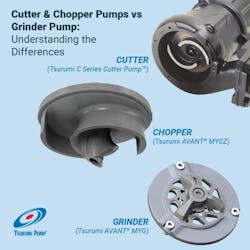Cutter and Chopper Pumps vs Grinder Pump: Understanding the Differences
Key Highlights
Cutter pumps have a tungsten carbide tipped open channel impeller which rotates within tight tolerance of a high chrome serrated wear plate.
Chopper pumps work almost identically, with a hard cast iron open channel impeller rotating against a stainless steel chopper knife.
Grinder pumps rely on a knife mechanism mounted to the pump shaft and seated against a strainer plate at the suction port.
Article by Tsurumi
As pumping challenges evolve, operators rely on their equipment to handle solids. Among the most common submersible solutions are cutter, chopper, and grinder pumps. While these three designs are often categorized together, their mechanisms, performance, and applications are distinct. Understanding these differences is key to specifying the right pump for the job.
Cutting Mechanisms: How Solids are Handled
At the core of each pump type is the way it tackles solids. The cutting mechanism not only defines how a pump breaks down debris, but also influences its performance, durability, and application that its best suited for.
· Cutter pumps have a tungsten carbide tipped open channel impeller which rotates within tight tolerance of a high chrome serrated wear plate. The cutting tip is hard enough to sharply cut objects that fall in between it and the stationary serrated wear plate.
· Chopper pumps work almost identically, with a hard cast iron open channel impeller rotating against a stainless steel chopper knife. The chopping occurs in a tight space between the impeller and chopper knife that runs parallel to one another.
· On the other hand, grinder pumps rely on a knife mechanism mounted to the pump shaft and seated against a strainer plate at the suction port. As fluid enters, the rotating grinder knife finely macerates solids, allowing only solids of safe size to pass through. Larger solids will be cut down further by the grinder.
Flow, Head, and Solid Types
Cutter and chopper pumps are versatile across a wide range of wastewater streams, from small, prefabricated basins and industrial waste collection to residential lift stations. When evaluating pumped material, single phase cutter pumps can be used when handling soft or easily manageable solids. Cutter and chopper pumps can handle small to medium flow wastewater and stormwater applications. For applications with a 10-inch discharge size or larger, it is recommended to use an open channel impeller as the larger pumps can pass solids without the risk of clogs.
Grinder pumps, by contrast, are often used in pressure sewer systems. The relatively short vane height and large diameter of the impeller allow them to generate high head at relatively low flow, making them ideal for pushing wastewater through small diameter pipes over long distances or steep vertical rises. Generally, grinder pumps produce relatively low flow at high pressure. While grinder pumps have the capability to handle a range of fluids, they primarily handle residential wastewater.
Clearance, Wear, and Keeping Cutting Surfaces Sharp
Across cutter, chopper, and grinder pump types, the most critical maintenance task is preserving clearance between impeller and solids handling mechanisms. As components wear, the clearance space widens, decreasing cutting effectiveness, similar to a loose pair of scissors. Manufacturers address this with design features that allow easily adjustable clearance space via washers, packing, or adjustment nuts. Routine inspection of the cutting surfaces ensures that the pump can continue to pass solids effectively.
Making the Right Choice for Long-Term System Reliability
While cutter and chopper pumps share similar mechanisms and applications, grinder pumps serve a different role. The key distinctions come down to system design, as cutters and choppers are recommended where solids vary and clog resistance is critical, and grinders where solids must be reduced to travel through small-diameter pressure pipes. Understanding these differences not only improves pump selection, but also enhances efficiency, reduces downtime, and extends the lift of wastewater collection systems.
